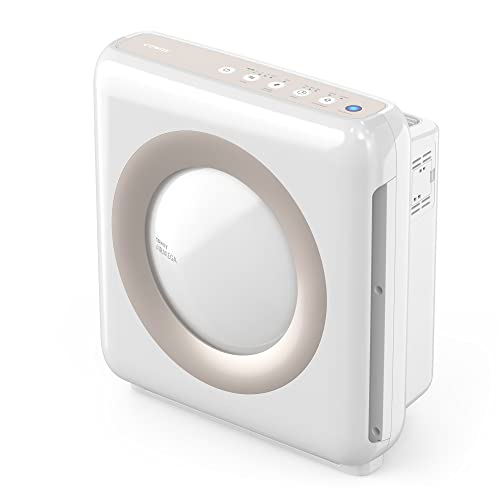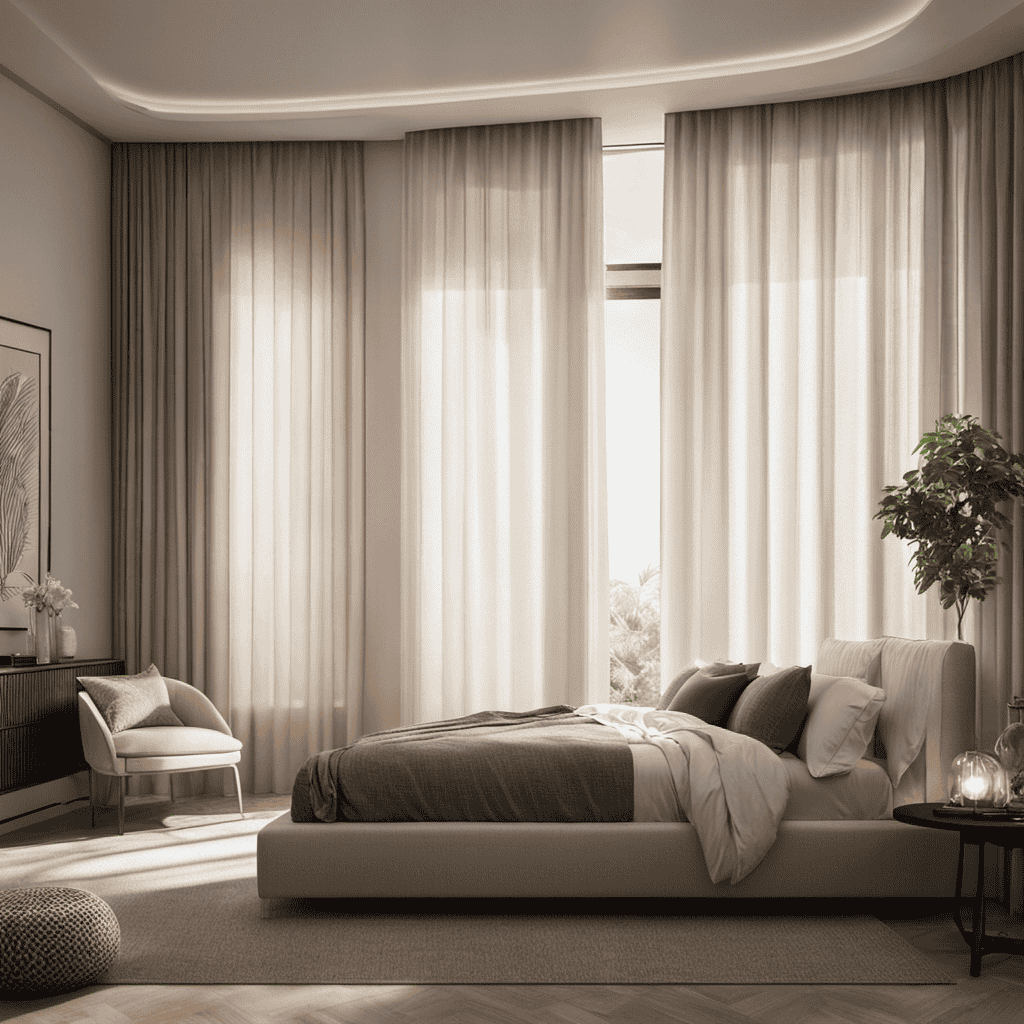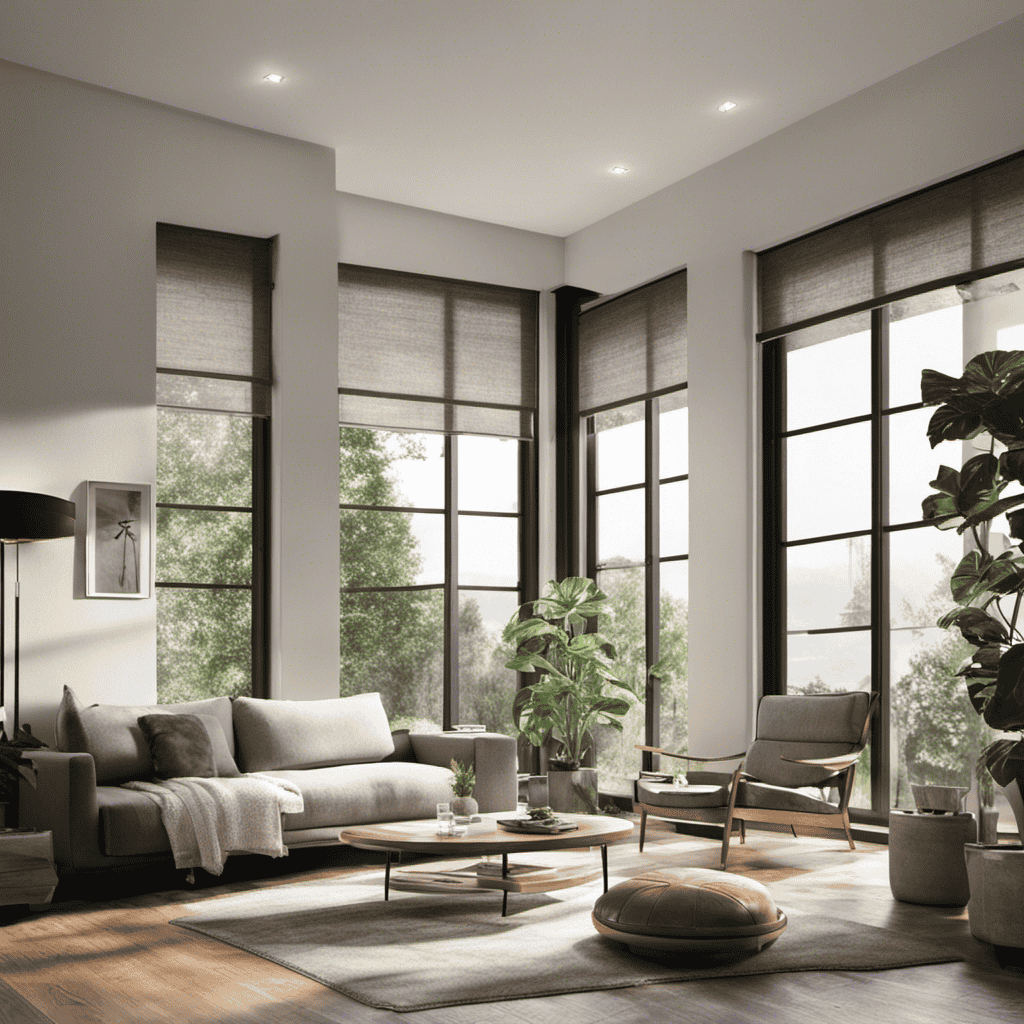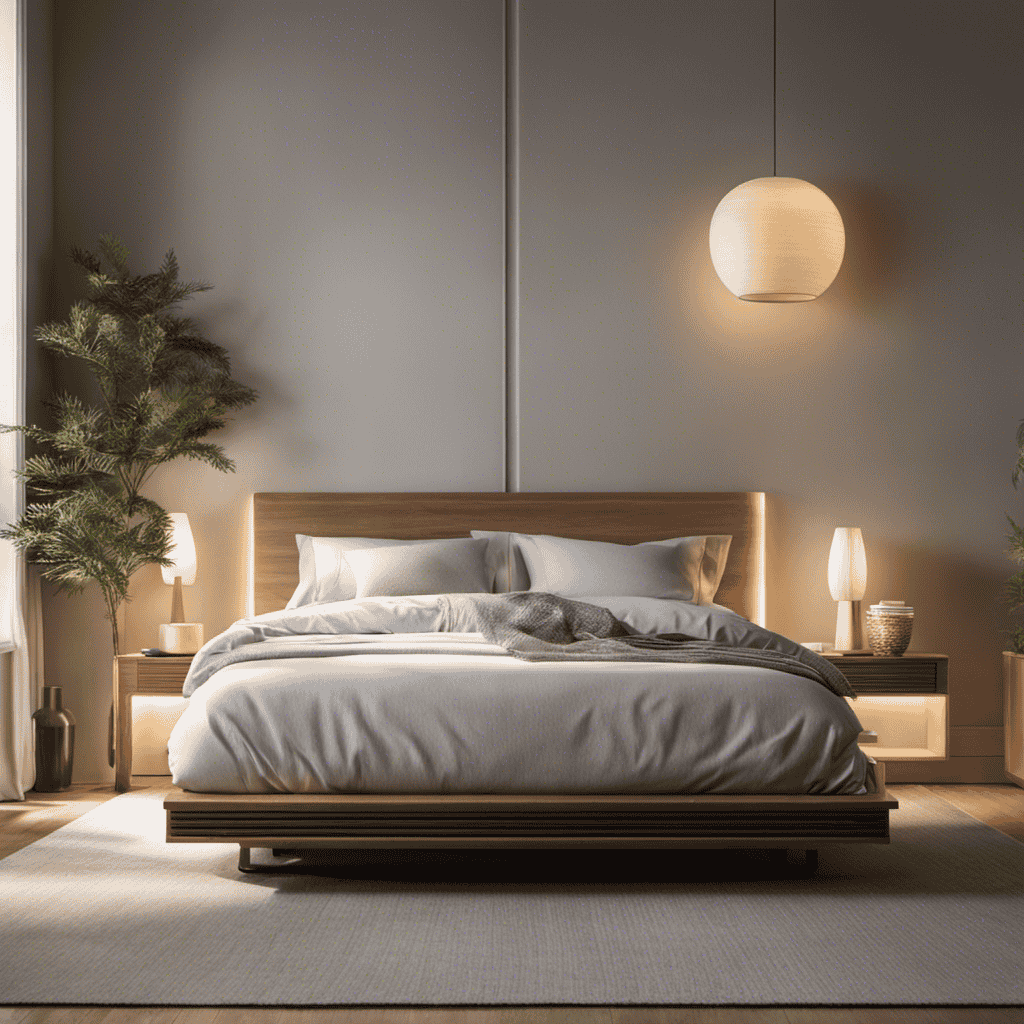I have always been worried about the air quality in my home, so when I found out that indoor air can be up to five times more polluted than outdoor air, I knew I needed to do something about it.
That’s when I came across the Coway Air Purifier. With its advanced features and easy-to-use controls, it has become an essential tool in improving the air I breathe.
In this article, I’ll guide you through the step-by-step process of using the Coway Air Purifier to ensure you have clean and fresh air in your home.
Key Takeaways
- The initial setup and control panel are important for proper functioning of the Coway Air Purifier.
- Adjusting the fan speed and setting the timer can help customize the air purification process.
- Choosing the right air purification mode and settings is crucial for optimal performance.
- Regular maintenance, such as installing and replacing filters, cleaning air filters, and troubleshooting, is necessary for efficient operation of the air purifier.
Unboxing and Initial Setup
To start unboxing your Coway air purifier, you’ll want to carefully cut the tape on the box and remove the packaging materials. It’s important to handle the purifier with care during this process to avoid any damage.
Once you have removed the packaging, you can begin the initial setup by finding a suitable location for your purifier. Make sure to place it in an area with good air circulation and away from any obstructions.
Next, plug in the power cord and turn on the unit. You may also need to insert the filters, which are usually located at the back of the purifier. Follow the manufacturer’s instructions to ensure proper installation.
With the initial setup complete, you can now move on to understanding the control panel and how to use your Coway air purifier effectively.
Understanding the Control Panel
Explore the control panel to adjust settings and maximize the efficiency of your Coway air purifier.
The control panel is located on the top of the air purifier and is easy to navigate. To start, press the power button to turn on the device.
Next, you can choose the purification mode that suits your needs by pressing the mode button. The available modes are Auto, Eco, and Sleep. Each mode adjusts the fan speed and power consumption accordingly.
The Auto mode automatically adjusts the fan speed based on the air quality, while the Eco mode saves energy by operating at a lower fan speed.
Finally, the Sleep mode operates at the lowest fan speed for a quiet and undisturbed night’s sleep.
Now, let’s dive into adjusting the fan speed in more detail.
Adjusting the Fan Speed
The control panel allows me to easily adjust the fan speed for optimal air purification. By adjusting the fan speed settings, I can customize the air flow to suit my preferences and the air quality in my environment.
The Coway air purifier offers different fan speed options, typically ranging from low to high. When the air quality is good, I can set the fan speed to low, which provides a quieter operation. On the other hand, when the air quality is poor or if I need faster air purification, I can increase the fan speed to high. This increases the airflow and ensures that the air is thoroughly filtered.
With the ability to adjust the fan speed, I have full control over the air purification process.
Setting the Timer
You can easily set the timer on the control panel to conveniently schedule when the fan speed will automatically adjust. This feature allows you to optimize the air purification process according to your needs. To set the timer, simply navigate to the timer function on the control panel and select the desired time. The air purifier will then automatically adjust the fan speed at the specified time.
When setting the timer, keep in mind these troubleshooting tips:
- Ensure that the current time and date are correctly set on the control panel.
- If the timer is not functioning as expected, try resetting it by turning off the air purifier and unplugging it from the power source for a few minutes.
- If the issue persists, refer to the user manual for further troubleshooting steps or contact customer support for assistance.
Choosing the Air Purification Mode
When it comes to choosing the right air purification mode for your Coway air purifier, there are a few key points to consider.
Firstly, it’s important to find the optimal purification settings that suit your specific needs and the air quality in your environment.
Additionally, noise level considerations should be taken into account, especially if you plan on using the purifier in a bedroom or office space.
Lastly, exploring energy-saving mode options can be beneficial in reducing power consumption and maximizing efficiency.
Optimal Purification Settings
To achieve optimal purification settings, it’s important to adjust the fan speed and timer based on the air quality in your environment. By properly maintaining your air purifier and making the necessary adjustments, you can ensure that it operates at its highest efficiency.
Here are three key factors to consider:
-
Fan Speed: Adjusting the fan speed allows you to control the airflow and filtration rate. For areas with high levels of pollutants, such as smoke or dust, setting the fan to a higher speed can help remove them more quickly and effectively.
-
Timer: Using the timer function helps conserve energy and prolong the lifespan of your air purifier. Set the timer to run for specific periods when you expect air quality to be poor, such as during cooking or cleaning activities.
-
Air Quality Sensor: Many air purifiers are equipped with air quality sensors that automatically adjust fan speed based on the detected level of pollutants. This feature ensures that your purifier operates at the optimal settings for maximum purification efficiency.
Noise Level Considerations
The noise level of the air purifier is an important consideration when choosing the optimal purification settings. To reduce noise, it’s crucial to select the right fan speed.
Coway air purifiers offer various fan speed options, allowing you to customize the noise level according to your preference. If you prefer a quieter environment, selecting a lower fan speed can help minimize noise. On the other hand, if you require more powerful purification, you can choose a higher fan speed, keeping in mind that it may generate more noise.
Finding the right balance between purification efficiency and noise level is key. By experimenting with different fan speeds, you can find the optimal setting that suits your needs.
Transitioning into the next section about energy-saving mode options, let’s explore how to conserve energy while maintaining a clean and quiet environment.
Energy-Saving Mode Options
Maximize energy efficiency by exploring the different options available for saving power while still maintaining a clean and quiet environment. With Coway air purifiers, you have the ability to customize your energy-saving mode to suit your needs.
Here are three key benefits of utilizing the energy-saving mode:
-
Adjustable fan speed: The energy-saving mode allows you to choose from multiple fan speed options, ranging from low to high. This feature ensures that the purifier operates at the optimal speed to clean the air effectively while minimizing energy consumption.
-
Timer function: The timer function allows you to schedule the air purifier to run for a specific duration. This ensures that the purifier only operates when needed, saving energy during periods when air purification is not necessary.
-
Smart sensors: Coway air purifiers come equipped with smart sensors that detect changes in air quality. The energy-saving mode utilizes these sensors to automatically adjust the fan speed and power consumption based on the air quality in the room. This ensures energy-efficient operation without compromising on air purification performance.
Installing and Replacing Filters
Make sure you’re properly installing and replacing filters in your Coway air purifier. Filter maintenance is essential to ensure the optimal performance of your air purifier and to keep the air in your home clean and fresh.
It is recommended to replace the filters in your Coway air purifier every six months or as indicated by the filter replacement guidelines provided by the manufacturer.
To install a new filter, first, make sure the air purifier is turned off and unplugged. Then, open the front cover and remove the old filter. Align the new filter with the grooves in the air purifier and push it firmly until it clicks into place. Close the front cover, plug in the air purifier, and turn it on.
Regularly checking and replacing your filters will ensure that your Coway air purifier continues to effectively remove pollutants from the air in your home.
Understanding the Air Quality Indicator
When it comes to understanding the air quality indicator on my Coway air purifier, there are three key points to consider.
First, the indicator color meanings provide valuable information about the current air quality in my environment. The colors range from blue for good air quality to red for poor air quality.
Second, by interpreting the air quality based on the indicator color, I can determine whether I need to take any actions. This could include adjusting the purification settings or opening windows for ventilation.
Lastly, taking appropriate actions is crucial. If the indicator shows poor air quality, it’s important to take steps to improve it. On the other hand, if the air quality is good, I can continue with my normal routine.
Understanding these three points will help me make the most of my air purifier and ensure that I am breathing clean and healthy air.
Indicator Color Meanings
To understand the indicator color meanings on your Coway air purifier, simply check the user manual for a detailed explanation. The indicator lights on your air purifier play a crucial role in keeping your indoor air clean and healthy. Here are the color meanings you need to know:
-
Green: This indicates that the air quality is excellent, and your air purifier is effectively removing pollutants from the air.
-
Yellow: This suggests that the air quality is moderate, and there might be some pollutants present. It is recommended to keep the air purifier running to maintain clean air.
-
Red: This means that the air quality is poor, and there are high levels of pollutants in the air. It is essential to address the source of pollutants and let the air purifier work to improve the air quality.
Interpreting Air Quality
Understanding the color indicators on your Coway air purifier is crucial for evaluating the quality of your indoor air. The color indicators provide a quick and easy way to monitor the air quality in your home.
The Coway air purifier uses a three-color system to represent different levels of air pollution. Green indicates good air quality, yellow indicates moderate pollution, and red indicates high pollution levels.
By regularly checking the color indicator, you can stay informed about the air pollution effects in your home. If you notice the indicator turning yellow or red, it is a clear sign that the air quality is deteriorating and immediate action should be taken.
Now that we understand how to interpret the air quality indicators, let’s move on to the next section about taking appropriate actions.
Taking Appropriate Actions
After interpreting the air quality, it is vital to take appropriate actions to ensure clean and fresh air in your surroundings. Coway air purifiers offer various troubleshooting techniques to address specific concerns. Here are three effective actions to take:
-
Clean the air filters regularly: By removing and cleaning the filters, you can eliminate dust, pollen, and other pollutants trapped inside. This simple maintenance task ensures optimal performance and extends the lifespan of the filters.
-
Adjust the fan speed: Depending on the air quality and your preference, you can adjust the fan speed to low, medium, or high. This allows for customized air purification and noise control.
-
Utilize the timer function: If you want the air purifier to run for a specific duration, you can set the timer accordingly. This helps conserve energy and ensures efficient operation.
By taking these appropriate actions, you can maximize the effectiveness of your Coway air purifier and enjoy cleaner air in your living space.
Now, let’s explore how to use the auto mode for effortless air purification.
Using the Auto Mode
Make sure you’ve set the Coway air purifier to Auto Mode so it can automatically adjust the fan speed based on the air quality in the room.
The Auto Mode utilizes advanced sensor technology to continuously monitor the air quality and make necessary adjustments. The air purifier is equipped with a combination of sensors that detect various pollutants, such as dust, pollen, and smoke particles. These sensors provide real-time feedback to the purifier, allowing it to react accordingly.
The benefits of using the Auto Mode are numerous. Firstly, it ensures that the air purifier is operating at the optimal fan speed to effectively remove pollutants from the air. Secondly, it saves energy by only running the fan at higher speeds when necessary. Lastly, it provides peace of mind, knowing that the air in your room is being constantly monitored and purified.
Utilizing the Sleep Mode
To optimize your air purifier’s performance while you sleep, simply activate the Sleep Mode feature. Sleep Mode is designed to provide you with a peaceful and clean sleeping environment.
Here are three benefits of using Sleep Mode:
-
Quiet operation: Sleep Mode ensures that your air purifier operates quietly, allowing you to sleep undisturbed. You won’t have to worry about any loud noises interrupting your restful night.
-
Energy efficiency: Sleep Mode conserves energy by adjusting the fan speed and power consumption to a lower level. This not only saves electricity but also reduces your carbon footprint.
-
Dimmed lights: The air purifier’s display lights are dimmed in Sleep Mode, preventing any unnecessary brightness from disturbing your sleep. You can rest comfortably without any distractions.
Now that you know the benefits of Sleep Mode, let’s move on to cleaning and maintaining your air purifier.
Cleaning and Maintaining the Air Purifier
When it comes to maintaining an air purifier, there are a few key points to keep in mind.
First, it’s important to understand the frequency at which the filters need to be replaced. This will vary depending on the model and usage, so it’s crucial to check the manufacturer’s recommendations.
Additionally, knowing the proper cleaning techniques for different parts of the air purifier is essential to ensure its effectiveness.
Lastly, regular maintenance is of utmost importance as it helps prevent the buildup of dust and other particles, ensuring that the air purifier continues to provide clean and fresh air.
Filter Replacement Frequency
The filter should be replaced regularly to ensure optimal performance of the Coway air purifier. Maintaining a proper filter replacement schedule is crucial for maintaining the efficiency of the purifier and prolonging the filter’s lifespan. Here are three important things to consider when it comes to filter replacement:
-
Frequency: It’s recommended to replace the filter every six months for normal household use. However, if you have pets or live in an area with high pollution levels, more frequent replacements may be necessary.
-
Signs of wear: Keep an eye out for signs of wear and tear, such as a decrease in air flow or a noticeable decrease in the purifier’s effectiveness. These signs may indicate that it’s time to replace the filter.
-
Filter type: Make sure to use the correct replacement filter recommended by Coway for your specific air purifier model. Using the wrong filter can affect the performance of the purifier.
By following a regular filter replacement schedule and paying attention to signs of wear, you can ensure that your Coway air purifier continues to provide clean, fresh air for your home.
Now, let’s move on to the next section about cleaning techniques for other parts of the air purifier.
Cleaning Techniques for Parts
Now, let’s see how you can clean the different parts of your Coway air purifier for optimal performance.
Regular cleaning of your air purifier is essential to ensure its efficiency and longevity. Start by unplugging the device and removing the front panel. Gently wipe the panel with a soft cloth or use a vacuum brush attachment to remove any dust or debris.
Next, take out the filter and tap it gently to remove loose particles. If the filter is washable, rinse it under running water and let it air dry completely before reinstalling.
For the outer casing, simply wipe it down with a damp cloth. Remember to clean the air vents and grilles regularly to prevent blockages.
Following these cleaning techniques and maintenance tips will help keep your Coway air purifier running smoothly and effectively.
Importance of Regular Maintenance
To ensure optimal performance and longevity, it’s important for you to regularly maintain and clean your Coway air purifier. Here are the key reasons why regular maintenance is crucial:
-
Efficient Filtration: Regularly replacing the filters in your air purifier ensures that it continues to efficiently remove pollutants from the air, providing you with clean and fresh air to breathe.
-
Improved Indoor Air Quality: A clean air purifier helps to eliminate allergens, dust, and other particles present in the air. This can greatly improve the overall air quality in your home, reducing the risk of respiratory issues and allergies.
-
Extended Lifespan: By keeping your air purifier clean and well-maintained, you can extend its lifespan and avoid unnecessary repairs or replacements.
Regular maintenance not only guarantees the effectiveness of your air purifier but also offers several benefits to your health and overall well-being.
Now, let’s move on to the next section about connecting to the Coway mobile app.
Connecting to the Coway Mobile App
First, make sure you’ve downloaded and installed the Coway Mobile App on your smartphone. The Coway Mobile App offers a range of features that enhance your experience with your Coway air purifier.
With the app, you can easily monitor the air quality in your home, control the purifier’s settings, and receive filter replacement reminders. It also provides real-time updates on indoor and outdoor air quality, allowing you to make informed decisions about when to use your air purifier.
However, if you encounter any connectivity issues with the app, there are a few troubleshooting steps you can try. First, ensure that your smartphone’s Bluetooth is turned on and that it is within range of the purifier. You can also try restarting both your smartphone and the purifier.
If the problem persists, contact Coway customer support for further assistance.
Monitoring and Controlling the Purifier Remotely
You can easily monitor and control the purifier’s settings remotely using the Coway Mobile App. With remote monitoring, you can stay updated on the air quality in your home even when you’re not there.
The app provides real-time feedback on the air quality index, allowing you to make informed decisions about when to turn on the purifier or adjust its settings. Remote control functionality enables you to turn the purifier on or off, adjust the fan speed, or switch between different modes from anywhere, using your smartphone.
This means you can come home to clean and fresh air, without having to manually operate the purifier.
The Coway Mobile App truly makes managing your air purifier a breeze.
Understanding the Filter Replacement Indicator
When it comes to understanding the filter replacement indicator on my Coway air purifier, there are a few key points to consider.
First, the filter lifespan indication is a helpful feature that lets me know when it’s time to replace the filter.
Second, following the manufacturer’s recommended replacement frequency guidelines is important to ensure optimal performance and air purification efficiency.
Lastly, if I need to reset the filter indicator after replacing the filter, there are simple steps I can follow to do so.
Overall, being aware of these aspects helps me maintain the effectiveness of my air purifier and ensure clean, healthy air in my home.
Filter Lifespan Indication
The Coway air purifier has a feature that indicates the lifespan of the filter. This feature is extremely helpful in ensuring that the air purifier is functioning optimally and that the air you breathe is clean and free from pollutants.
The filter lifespan indication is displayed on the control panel of the air purifier and can be easily interpreted. Here are three visual cues that the Coway air purifier uses to indicate the filter status:
-
Green light: When the light is green, it means that the filter is still in good condition and has a long lifespan remaining.
-
Yellow light: A yellow light indicates that the filter is approaching the end of its lifespan and will need replacement soon.
-
Red light: When the light turns red, it means that the filter has reached its maximum lifespan and needs immediate replacement.
Replacement Frequency Guidelines
Understanding the recommended replacement frequency guidelines for the filter is essential in maintaining optimal air quality. Regularly replacing the filter ensures that it continues to effectively capture pollutants and allergens, keeping the air in your home clean and healthy. The recommended replacement frequency will depend on various factors, including the model of your Coway air purifier and the air quality standards in your area. To help you determine when it’s time to replace the filter, refer to the table below:
| Model | Filter Type | Recommended Replacement Frequency |
|---|---|---|
| AP-1012GH | Pre-filter + True HEPA | 6 months |
| AP-1512HH | Pre-filter + Carbon + True HEPA | 12 months |
| Airmega 300 | Pre-filter + Max2 filter | 12 months |
| Airmega 400 | Pre-filter + Max2 filter | 12 months |
| Airmega 400S | Pre-filter + Max2 filter | 12 months |
Resetting the Filter Indicator
Resetting the filter indicator is a simple process that ensures you stay informed about when to replace your air purifier’s filter. It is essential to interpret filter changes accurately to maintain the efficiency of your air purifier. Troubleshooting maintenance issues can be easily done by following these steps:
-
Check the filter indicator light: Look for the indicator light on your air purifier that signals when it’s time to replace the filter. It may be a flashing light or a specific color.
-
Refer to the user manual: Consult the user manual to understand the specific instructions for resetting the filter indicator. Each air purifier model may have a different method.
-
Follow the reset procedure: Typically, resetting the filter indicator involves pressing and holding a specific button for a set amount of time. This action will clear the filter replacement reminder and prepare it for the next cycle.
Troubleshooting Common Issues
If your Coway air purifier isn’t working properly, there are a few common issues you can troubleshoot.
First, check if the power cord is securely plugged into an outlet. Sometimes, a loose connection can prevent the purifier from turning on.
Next, make sure the air filter is clean and properly installed. A dirty or incorrectly placed filter can hinder the purifier’s performance.
Additionally, check the control panel for any error messages or unusual settings. Resetting the purifier to its default settings may resolve any software-related issues.
Finally, ensure that the purifier is placed in an appropriate location, away from obstructions and with sufficient airflow.
Following these troubleshooting tips can help you identify and resolve common issues with your Coway air purifier.
Tips for Optimal Air Purification
To achieve the best air purification results, make sure you place your Coway purifier in a central location within the room. This will allow for optimal air circulation and ensure that the purifier can effectively reduce indoor pollutants.
Here are three tips to help you create a clean and healthy environment:
- Position the purifier away from walls or furniture to allow for unrestricted airflow.
- Avoid placing the purifier near sources of dust or pollutants, such as open windows or kitchen areas.
- Consider the size of the room when choosing the appropriate purifier model, as larger spaces may require a more powerful unit to effectively clean the air.
Following these tips will help you maximize the performance of your Coway purifier and create a healthier indoor environment by reducing the presence of pollutants.
Frequently Asked Questions
How Often Should I Clean the Exterior of the Air Purifier?
I clean the exterior of my air purifier regularly to ensure optimal performance. It’s important to maintain cleanliness to prevent dust buildup and maintain the efficiency of the purifier. Regular cleaning is key for proper maintenance.
Can I Use the Coway Air Purifier in a Large Room or Open Space?
Sure, I can use the Coway air purifier in a large room or open space. It’s designed to effectively purify the air in such areas, giving me clean and fresh air to breathe.
Is It Safe to Leave the Air Purifier on All Day and Night?
Yes, it’s safe to leave the air purifier on all day and night. Regular air purifier maintenance is important to ensure optimal performance. Using an air purifier has numerous benefits, such as removing allergens and improving indoor air quality.
Can I Use Essential Oils With the Coway Air Purifier?
Yes, you can use essential oils with the Coway Air Purifier. Adding a few drops of your favorite oil can enhance the benefits of the purifier by freshening the air and creating a pleasant aroma.
What Should I Do if the Air Purifier Emits a Strange Odor?
If my Coway Air Purifier emits a strange odor, I would first check if the filter needs to be replaced. If the odor persists, I would contact customer support for further troubleshooting and assistance.
Can the Coway Air Purifier be Cleaned Like a Hepa Filter Air Purifier?
Yes, the Coway air purifier can be cleaned like a Hepa filter air purifier. Regularly cleaning the Coway air purifier is essential to maintain its efficiency. By following the manufacturer’s instructions, you can easily clean the HEPA filter and ensure that the air purifier continues to effectively clean the air in your home.
Conclusion
In conclusion, using the Coway air purifier has been a breath of fresh air.
With its easy unboxing and setup, intuitive control panel, and customizable features like fan speed and timer, it truly puts the power of clean air in your hands.
Like a conductor leading an orchestra, this purifier harmonizes with your needs, effortlessly removing pollutants from your surroundings.
With the added convenience of remote monitoring and filter replacement indicators, maintaining optimal air quality has never been easier.
Say goodbye to common air issues and embrace the serenade of pure, clean air.











